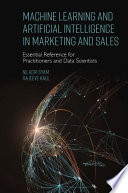

The book begins by establishing a solid foundation in the concepts of artificial intelligence (AI) and machine learning (ML). It explains how these technologies work, the differences between them, and their relevance in the context of marketing and sales. AI refers to the capability of a machine to imitate intelligent human behavior, while machine learning is a subset of AI that allows systems to learn from data and improve their performance over time without being explicitly programmed. The authors emphasize the importance of grasping these fundamentals to leverage them effectively in marketing strategies. They discuss various algorithms and models, such as supervised and unsupervised learning, and how they can be applied to analyze consumer behavior, predict trends, and optimize marketing campaigns. By understanding these concepts, marketers can make data-driven decisions that enhance customer engagement and drive sales.
Continue readingA significant theme in the book is the shift towards data-driven decision-making in marketing and sales. The authors illustrate how organizations can harness vast amounts of data generated from customer interactions, social media, and online behavior to inform their strategies. They detail the process of collecting, processing, and analyzing data to extract actionable insights. The book also discusses the importance of having a robust data infrastructure and the role of data analytics in identifying patterns and trends that can lead to more effective marketing campaigns. By employing machine learning algorithms, businesses can segment their audiences more accurately, personalize their messaging, and predict customer needs, thereby enhancing customer satisfaction and loyalty. The authors provide case studies and examples of companies that have successfully implemented data-driven strategies, showcasing the tangible benefits of this approach.
Continue readingPersonalization is one of the most powerful applications of AI and ML in marketing. The book highlights how businesses can use these technologies to create tailored experiences for their customers. By analyzing customer data, companies can understand individual preferences and behaviors, allowing them to deliver personalized content, product recommendations, and marketing messages. The authors discuss various tools and techniques, such as recommendation engines and dynamic content generation, that can enhance the customer experience. They also emphasize the importance of maintaining a balance between personalization and privacy, as consumers are increasingly concerned about how their data is used. The book provides insights into best practices for implementing personalization strategies that resonate with customers while respecting their privacy.
Continue readingThe authors delve into the role of predictive analytics in sales forecasting, showcasing how machine learning models can analyze historical sales data to predict future performance. They explain various techniques, such as regression analysis and time series forecasting, and how these can be applied to improve sales strategies. By leveraging predictive analytics, businesses can identify potential opportunities and risks, allowing them to make informed decisions about inventory management, resource allocation, and marketing efforts. The book includes practical examples of how organizations have successfully implemented predictive analytics to enhance their sales forecasting accuracy, ultimately leading to increased revenue and market share. This section underscores the importance of integrating predictive analytics into the sales process to stay ahead of the competition.
Continue readingAutomation is a key benefit of AI and machine learning in marketing. The book discusses how businesses can automate repetitive tasks, such as email marketing, social media posting, and customer segmentation, to improve efficiency and effectiveness. The authors explore various automation tools and platforms that leverage AI to streamline marketing processes, allowing teams to focus on strategic initiatives rather than mundane tasks. By automating these processes, companies can achieve greater consistency in their marketing efforts and respond more quickly to customer interactions. The book also addresses the challenges associated with automation, such as ensuring quality control and maintaining a human touch in customer interactions. Overall, this section highlights the transformative potential of automation in enhancing marketing productivity.
Continue readingAs AI and machine learning become more prevalent in marketing, ethical considerations come to the forefront. The book addresses the potential risks and ethical dilemmas associated with the use of AI, such as bias in algorithms, data privacy concerns, and the transparency of AI-driven decisions. The authors advocate for responsible AI practices, emphasizing the need for marketers to be aware of the implications of their technologies on consumers and society. They provide guidelines for implementing ethical AI practices, such as ensuring fairness in algorithmic decision-making and being transparent about data usage. This section encourages marketers to adopt a principled approach to AI, fostering trust and accountability in their relationships with customers.
Continue readingThe book concludes by exploring future trends in AI and marketing, providing insights into how these technologies will continue to evolve and shape the industry. The authors discuss emerging technologies, such as natural language processing, chatbots, and augmented reality, and their potential applications in marketing and sales. They emphasize the importance of staying ahead of the curve and being adaptable to change, as the marketing landscape is constantly evolving. The book encourages readers to embrace innovation and continuously seek out new opportunities to leverage AI and machine learning in their marketing strategies. By being proactive in adopting new technologies, businesses can maintain a competitive edge and drive long-term growth.
Continue reading